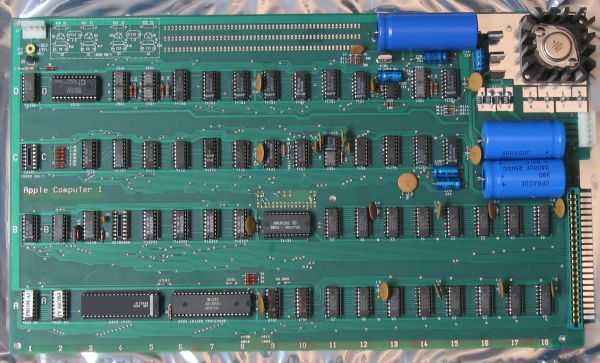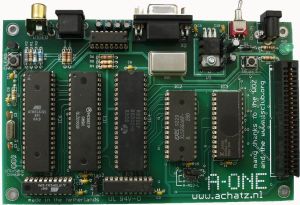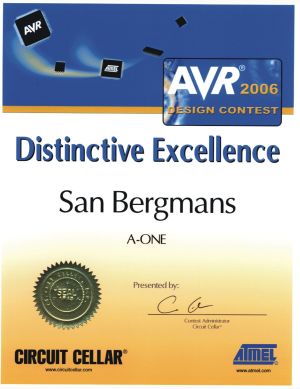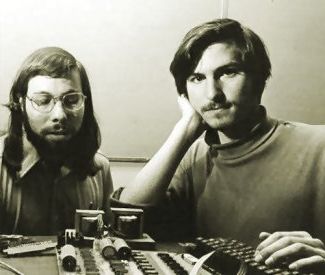The Apple 1

A beautiful Apple 1 clone, built by Bryan Blackburn
I must confess something: History never was my favourite subject at school.
And yet I dive right back into history in this corner of my web site, back to the very beginning of modern computers.
It's like riding a time machine, going back to when the Apple company was born, a little more than 30 years ago as of this writing.
It was on the first of April 1976 when Steve Wozniak and his friend Steve Jobs went to market with the Apple 1 computer.
I've been told that they've sold some 200 of them, before it was replaced by the more advanced and better known Apple ][ computer.
Well, that is what you can read on almost all the web sites referring to the Apple 1.
Those sites even tell you that it originally sold for $666.66 with only 4k of memory!
And that one of the approximately 50 remaining Apple 1's was sold in an auction for about $50.000 a few years ago!
I'm not going to repeat all the history facts and figures on this site.
No, I'm going to delve deeper into the operation of the Apple 1.
That's the great thing about these old computers, you can still understand every bit (binary digit) of it.
A Little Introduction To The Apple 1
Computers and humans do not speak the same language.
Fortunately computers have come a long way to learn to understand what we humans want them to do, thanks to graphical user interfaces.
However back in '76 computers were far from being human-friendly.
They had to be spoken to in their own native language: binary numbers.
Steve Wozniak and his Apple company were among the first to change that a little.
His Apple 1 computer came one step closer to us humans.
Obviously computers still had a long way to go, but it was considered a giant leap for computer users back then.
The Apple 1 was programmable with hexadecimal numbers, instead of binary numbers.
It had a real keyboard, instead of a large set of toggle switches and flashing lights.
And it had a screen which could show 24 lines of 40 characters each, instead of about 6 seven-segment displays (at best).
OK we humans were still the ones who had to adapt the most, but from then on computers did their utmost to better integrate with us.
On the Apple 1 this human interface was controlled by the monitor program, better known as the Woz Monitor, named after its creator. A total of 256 bytes of ROM memory were responsible for holding the Woz Monitor and allowing the computer to do something sensible when the RESET switch was pressed. Doesn't sound much, only 256 bytes, but keep in mind that memory was extremely expensive in those days. And hey, it's always 256 bytes more than Apple's main competitor at that time, the Altair 8800, which had no ROM at all and no terminal screen or keyboard!
Why Apple 1?
You may wonder why I'm interested in the Apple 1.
Many people consider it to be the first true home computer because it had a built in terminal.
Of course it is also the first true product of the Apple Computer Company.
But I think the main reason is that I think the story behind Steve Woziniak and his Apple 1 sounds very familiar to my personal story.
Like Steve I started "creating" my own computer on paper, both hardware and software.
Also like Steve I started out as an electronics engineer who was interested in computers.
I even started programming by hand assembling my assembly programs too.
But unlike Steve I was born a few years too late and on the wrong side of the ocean.
And unlike Steve I didn't have a friend who started a business with me.
Before I could afford my own computer I dwelled on building my own, based around the Motorola 6809.
It was a few years later that I finally created a project around a 6809, a slide projector controller.
My first computer was an Apple ][+.
And although I was forced to switch to Intel machines about a decade later, I still treasure the good times I spent together with my good old Apple computer.
Do I Want To Own An Apple 1?
Who wouldn't? Only 200 were built and about 50 are presumed to have survived. Therefore an original Apple 1 is practically unaffordable. I can't help you with that. But all hope is not lost yet, there are several alternatives.
Undoubtedly the cheapest Apple 1 you could have is an emulator.
This is simply a program which runs on a modern PC and behaves exactly like a real Apple 1 (with much more memory).
I recommend Ken Wessen's version of the POM1 emulator.
Ken has fixed some bugs and added some extra features to the original POM1 emulator.
I never got the original POM1 to work, but Ken's version is perfect.
 Simply download his Krusader package and you'll get the emulator as a bonus.
Simply download his Krusader package and you'll get the emulator as a bonus.
I know, an emulator is nice to speed up development of your Apple 1 killer application, but it is not the real thing. The next best thing is to buy one of available Apple 1 replica's. Original components are hard to come by these days. Therefore the replica's use modern chips to replace the "difficult" parts. However the computer part of the replicas is exactly the same as in a real Apple 1, which makes them behave exactly the same as the real thing.
At the moment of this writing there are two alternative sources to get an Apple 1 replica:
Achatz Electronics in the Netherlands where you can buy the A-One, a small but complete Apple 1 replica.
Unfortunately Franz has stopped selling them.
Briel Computers was the first with his Replica 1.
It's up to you to decide which one you like best.
Personally I prefer the A-One (because I helped develop it :-)
A Reward From Circuit Cellar
By the way, Franz and I received a "Distinctive Excellence" reward from those nice people at Circuit Cellar back in 2006.


Navigation
Sponsors
Please consider clicking on the Support Me button to show your appreciation.
![]()
My way of keeping this site alive.
 Computers and humans do not speak the same language.
Fortunately computers have come a long way to learn to understand what we humans want them to do, thanks to graphical user interfaces.
Computers and humans do not speak the same language.
Fortunately computers have come a long way to learn to understand what we humans want them to do, thanks to graphical user interfaces.
![Apple ][ Logo Apple ][ Logo](apple2logo.jpg) Like Steve I started "creating" my own computer on paper, both hardware and software.
Also like Steve I started out as an electronics engineer who was interested in computers.
I even started programming by hand assembling my assembly programs too.
But unlike Steve I was born a few years too late and on the wrong side of the ocean.
And unlike Steve I didn't have a friend who started a business with me.
Like Steve I started "creating" my own computer on paper, both hardware and software.
Also like Steve I started out as an electronics engineer who was interested in computers.
I even started programming by hand assembling my assembly programs too.
But unlike Steve I was born a few years too late and on the wrong side of the ocean.
And unlike Steve I didn't have a friend who started a business with me.
